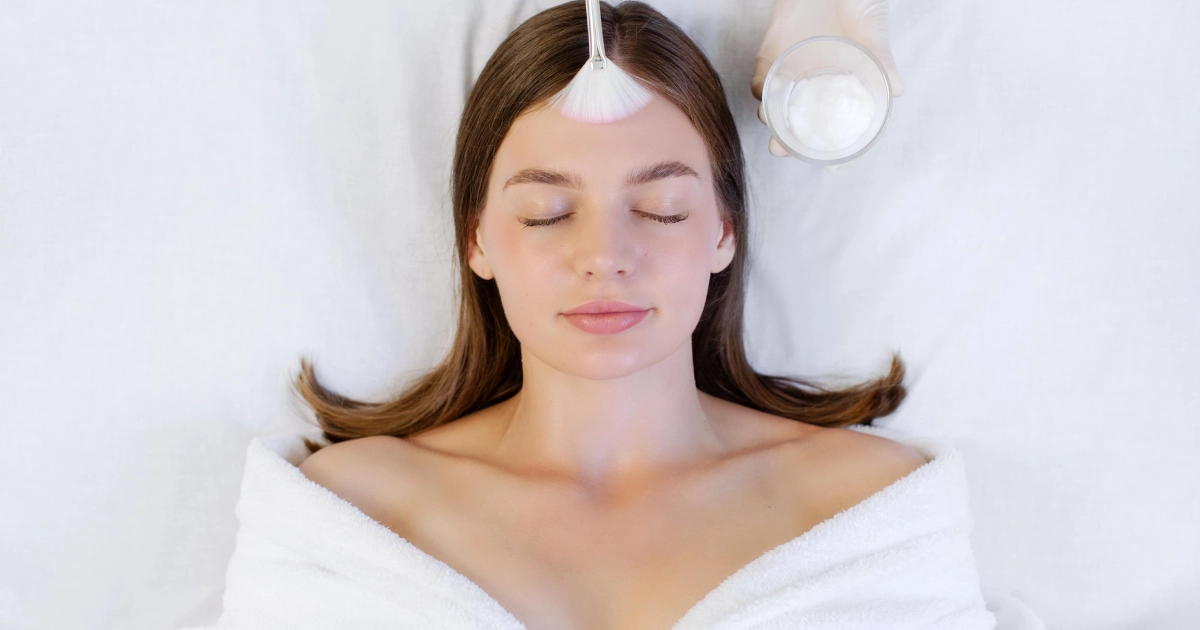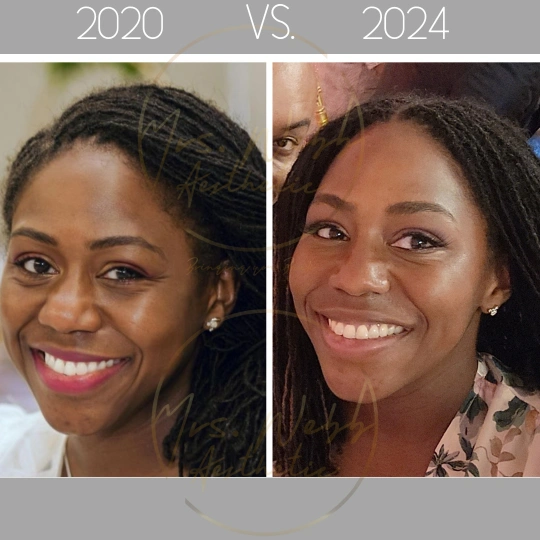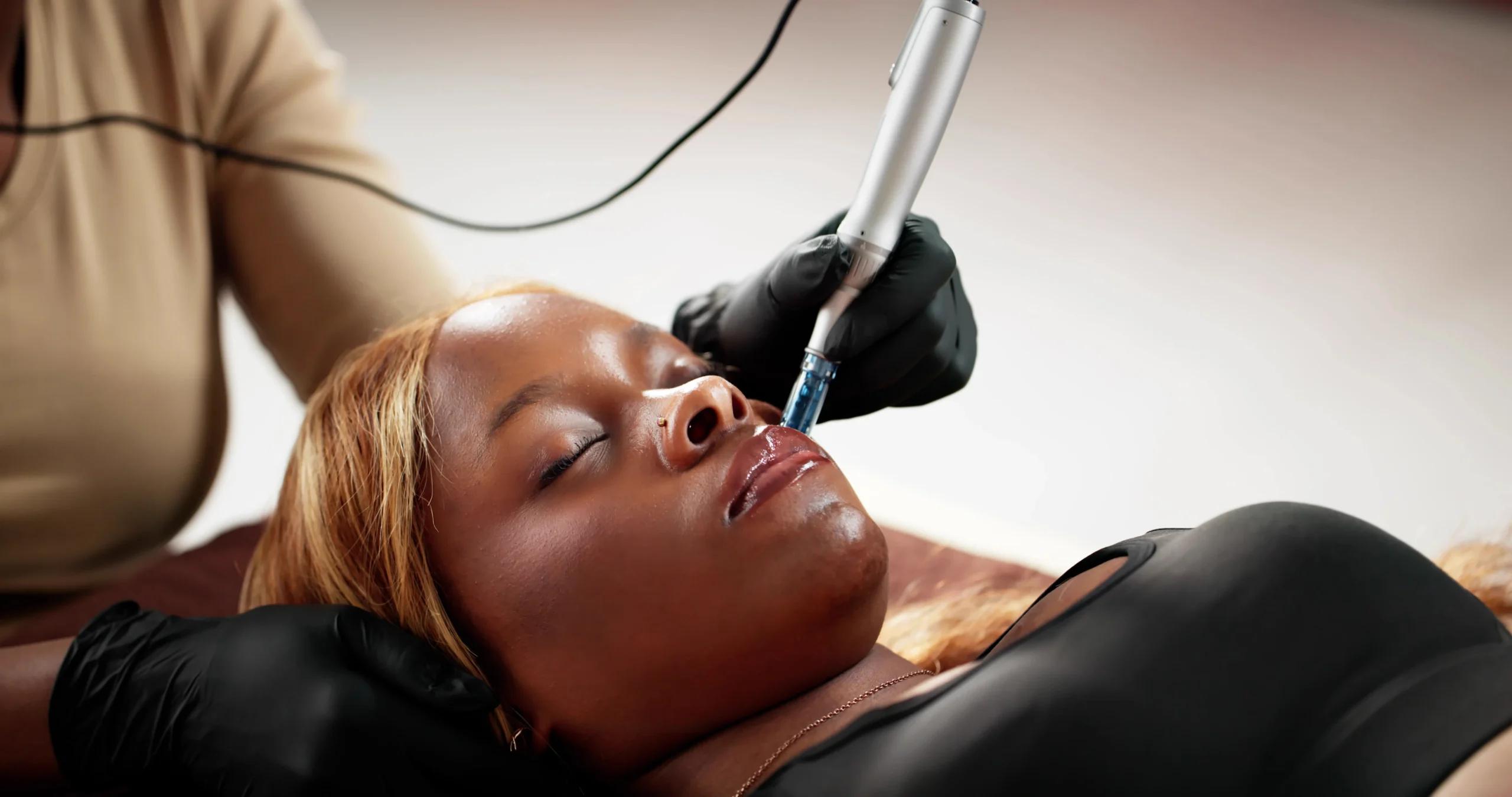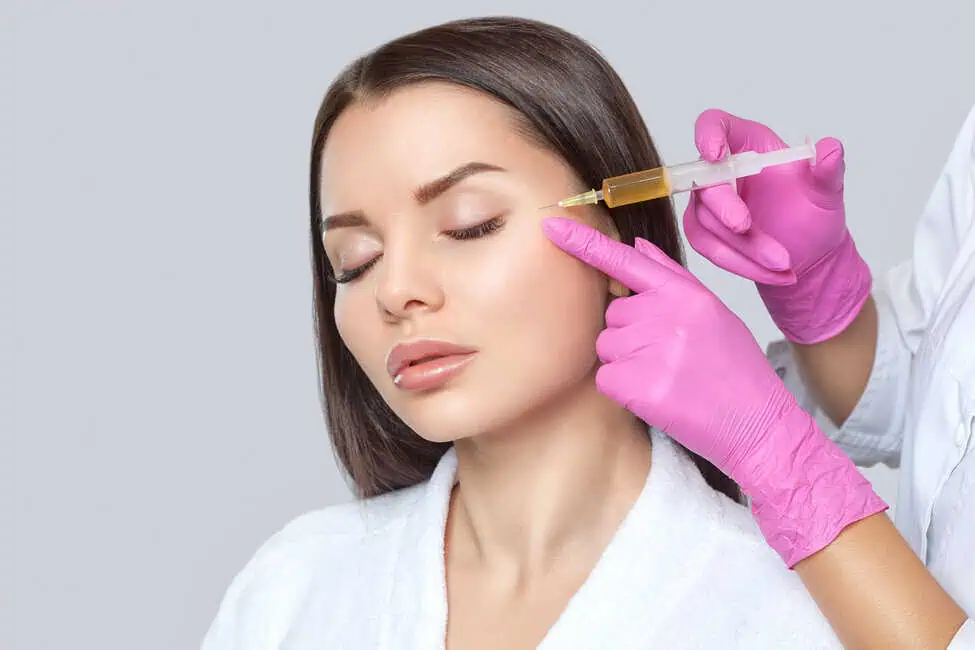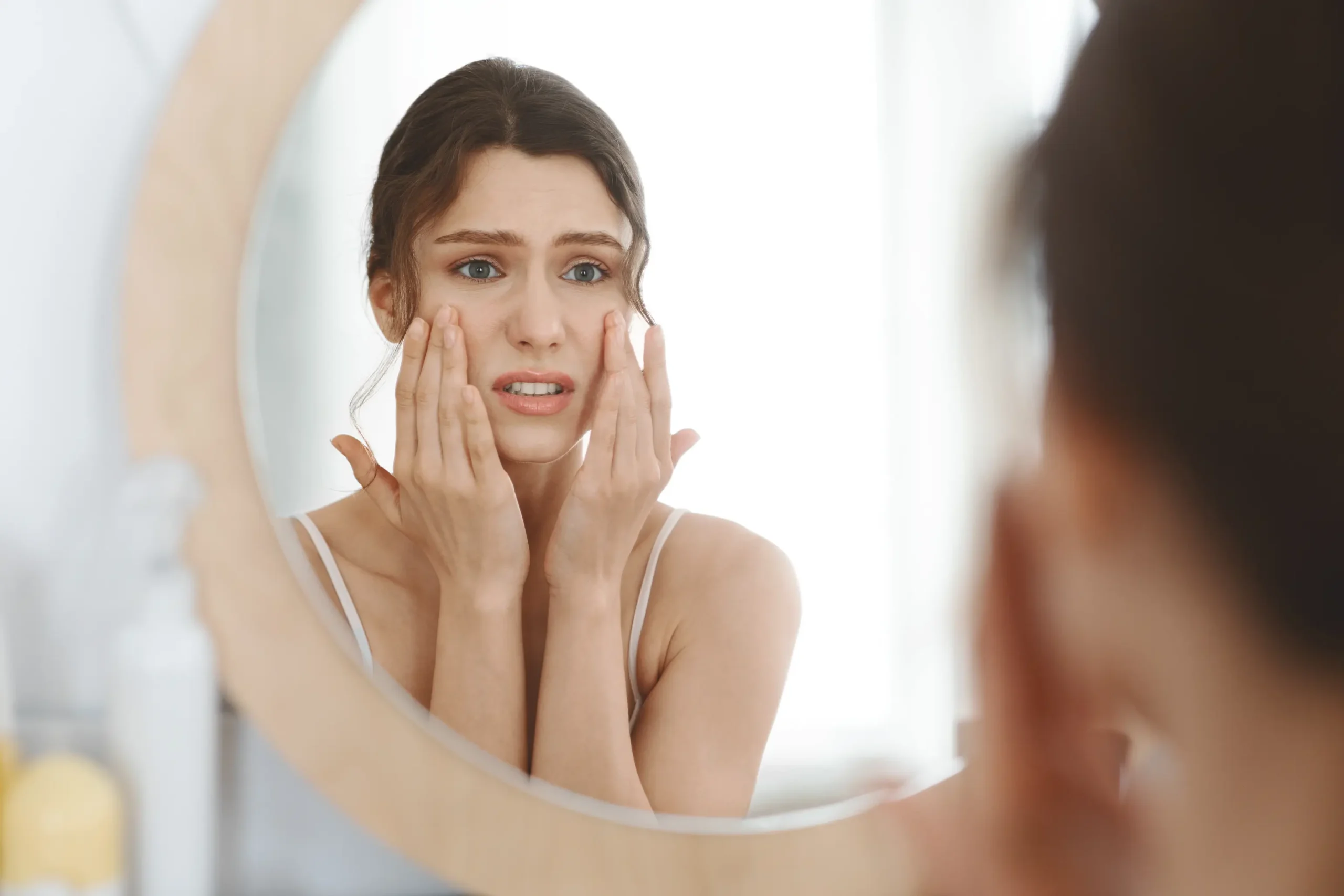Aesthetic treatments like chemical peels and lasers can work wonders for many. However, individuals with medium to dark skin tones (Fitzpatrick IV-VI) —should approach these treatments cautiously. Understanding this group’s unique risks and benefits can help ensure a safe and effective treatment.
What is Fitzpatrick Skin Type?
The Fitzpatrick skin type scale classifies skin based on its response to UV exposure. There are six categories, ranging from Type I (very fair, always burns, never tans) to Type VI (intensely pigmented, never burns). Higher Fitzpatrick types, such as IV-VI, tend to have more melanin, which provides some natural protection against UV rays but can also make the skin more prone to hyperpigmentation and visible scarring.
Microneedling for Darker (Fitzpatrick IV-VI) Skin Tones
Microneedling can benefit those with darker skin tones when performed correctly despite the risks.
As a popular skin treatment, microneedling involves using a motorized device to create controlled micro-injuries to the skin. These micro “wounds” spur a process of “scarless wound healing” (Spataro et al., 2023). It also releases noninflammatory growth factors and triggers collagen and elastin formation in the skin (Hou et al., 2017).
Unlike other procedures, such as chemical peels or laser therapy, microneedling does not compromise the outermost (epidermis) layer of skin, offering less risk of developing post-inflammatory hyperpigmentation (PIH), aka dark spots ( Sun et al.,2024).
The Benefits of Microneedling for Darker (Fitzpatrick IV-VI) Skin Tones
Microneedling is widely praised for its ability to reduce scarring, and improve skin texture and tone. It’s effective for various concerns, including fine lines, hyperpigmentation, and acne scars.
Reduction of Hyperpigmentation
One of the most significant benefits of microneedling for higher Fitzpatrick types is its ability to treat hyperpigmentation, a common concern in darker skin. As a result of stimulating collagen production and increasing cell turnover, microneedling reduces dark spots and improves skin tone over time. It benefits those with dark spots (PIH) caused by acne or other skin injuries.
Scar Treatment
Microneedling is well-known for its ability to reduce the appearance of scars, including acne scars. For individuals with higher Fitzpatrick skin types, who are more prone to developing darker, more noticeable scars, microneedling can break down fibrous tissue and stimulate new skin growth. This process can make scars appear less prominent and improve skin texture.
Overall Skin Texture and Firmness
As a result of stimulating collagen and elastin production, microneedling can help with the overall texture and elasticity of the skin. As skin becomes firmer, fine lines and wrinkles can soften, contributing to a smoother and more youthful appearance. This is beneficial for those with age-related skin concerns and those looking to improve the general appearance of their skin.
Minimally Invasive Treatment
In contrast to more invasive procedures such as chemical peels and laser treatments, microneedling is relatively low-risk and requires little to no downtime. For darker skin types who may be wary of more aggressive therapies, microneedling offers a gentler approach that still provides impressive results.
Risks of Microneedling for Higher Fitzpatrick Skin Types
While the benefits are clear, microneedling does come with potential risks, especially for individuals with darker skin tones. Considering these risks against the benefits and working with an experienced professional to minimize complications is essential.
Post-Inflammatory Hyperpigmentation (PIH)
Skin can be so confusing, I know.
Didn’t I say that microneedling works well for this problem? Yes, I did.
Any injury to the epidermis can result in post-inflammatory hyperpigmentation (PIH). While microneedling intentionally creates controlled micro-injuries to the skin, there is still a risk of triggering PIH, especially in sensitive areas or if the treatment is overly aggressive.
Keloid Scarring
Darker-skinned folks are at a higher risk for developing keloid scars—raised, thick, and sometimes itchy scars that form during healing. If the microneedling procedure is too intense or not performed with proper aftercare, there is a potential for keloid formation, especially in areas where the skin has been previously injured.
Hyperpigmentation from Overuse
Another risk for darker skin tones is the potential for uneven pigmentation if microneedling is done too frequently. Overuse can exacerbate pigmentation issues and cause more harm than good. To avoid this, giving the skin adequate time to heal between treatments is essential.
Infection Risk
Any skin treatment that involves breaking the skin’s surface comes with the risk of infection, and microneedling is no exception. If not performed in the correct environment or if aftercare instructions are not followed, there is a risk of infection, leading to scarring or worsening of existing skin concerns.
Mitigating Risks and Ensuring Success
If you’re considering microneedling and have a higher Fitzpatrick skin type, there are several ways to minimize risks and maximize the benefits:
Work with a Skilled Practitioner
Choosing a professional with experience working with darker skin tones is essential. They should understand and respect your skin’s unique needs, know how to adjust needle depth, avoid drag, and avoid overly aggressive treatments that could lead to complications like hyperpigmentation or scarring.
Post-Treatment Care is Crucial
Follow all aftercare instructions to ensure optimal healing. This may include avoiding direct sunlight, using gentle moisturizers, and applying a broad-spectrum sunscreen to prevent further dark spot issues. You may also need specific treatments that soothe and support skin healing, such as vitamin C or hyaluronic acid serums.
Limit Frequency of Treatments
Microneedling should not be done too frequently. The skin needs time to heal and recover. Most professionals recommend spacing treatments at least two to four weeks apart, depending on your treatment plan, to give your skin the best chance to regenerate.
Conclusion
Microneedling can effectively treat dark-skinned individuals, offering significant benefits like improved skin texture, reduced scarring, and diminished hyperpigmentation. However, knowing the risks and best practices is crucial to prevent a poor result. Wherever you are located, select a skilled practitioner to adjust the treatment plan to suit your skin. Remember to follow proper aftercare, and you can safely enjoy the many benefits of microneedling.
At Mrs. Webb’s Aesthetic Marine Park location, we specialize in tailoring treatments to fit your skin type, lifestyle, and aesthetic goals. Follow me on IG at Injectedby_Mrs.Webb for in-office promotions and giveaways. Please book an appointment through our online portal!
Until next time,
Dr. Laurel B.
References
Aesthetic Clinician’s Guide to Platelet Rich Plasma. (2021).
https://doi.org/10.1007/978-3-030-81427-4
Hou, A., Cohen, B., Haimovic, A., & Elbuluk, N. (2017). Microneedling: A Comprehensive Review. Dermatologic surgery : official publication for American Society for Dermatologic Surgery [et al.], 43(3), 321–339.
https://doi.org/10.1097/DSS.0000000000000924
Spataro, E. A., Dierks, K., & Carniol, P. J. (2023). Microneedling-Associated Procedures to Enhance Facial Rejuvenation. Clinics in plastic surgery, 50(3), 479–488. https://doi.org/10.1016/j.cps.2022.12.012
Sun, X., Jia, X. & Huang, L. Microneedling Therapy for Striae Distensae: Systematic Review and Meta-Analysis. Aesth Plast Surg 48, 2915–2926 (2024). https://doi.org/10.1007/s00266-024-03954-x
Aesthetic treatments like chemical peels and lasers can work wonders for many. However, individuals with medium to dark skin tones (Fitzpatrick IV-VI) —should approach these treatments cautiously. Understanding this group’s unique risks and benefits can help ensure a safe and effective treatment.
What is Fitzpatrick Skin Type?
The Fitzpatrick skin type scale classifies skin based on its response to UV exposure. There are six categories, ranging from Type I (very fair, always burns, never tans) to Type VI (intensely pigmented, never burns). Higher Fitzpatrick types, such as IV-VI, tend to have more melanin, which provides some natural protection against UV rays but can also make the skin more prone to hyperpigmentation and visible scarring.
Microneedling for Darker (Fitzpatrick IV-VI) Skin Tones
Microneedling can benefit those with darker skin tones when performed correctly despite the risks.
As a popular skin treatment, microneedling involves using a motorized device to create controlled micro-injuries to the skin. These micro “wounds” spur a process of “scarless wound healing” (Spataro et al., 2023). It also releases noninflammatory growth factors and triggers collagen and elastin formation in the skin (Hou et al., 2017).
Unlike other procedures, such as chemical peels or laser therapy, microneedling does not compromise the outermost (epidermis) layer of skin, offering less risk of developing post-inflammatory hyperpigmentation (PIH), aka dark spots ( Sun et al.,2024).
The Benefits of Microneedling for Darker (Fitzpatrick IV-VI) Skin Tones
Microneedling is widely praised for its ability to reduce scarring, and improve skin texture and tone. It’s effective for various concerns, including fine lines, hyperpigmentation, and acne scars.
Reduction of Hyperpigmentation
One of the most significant benefits of microneedling for higher Fitzpatrick types is its ability to treat hyperpigmentation, a common concern in darker skin. As a result of stimulating collagen production and increasing cell turnover, microneedling reduces dark spots and improves skin tone over time. It benefits those with dark spots (PIH) caused by acne or other skin injuries.
Scar Treatment
Microneedling is well-known for its ability to reduce the appearance of scars, including acne scars. For individuals with higher Fitzpatrick skin types, who are more prone to developing darker, more noticeable scars, microneedling can break down fibrous tissue and stimulate new skin growth. This process can make scars appear less prominent and improve skin texture.
Overall Skin Texture and Firmness
As a result of stimulating collagen and elastin production, microneedling can help with the overall texture and elasticity of the skin. As skin becomes firmer, fine lines and wrinkles can soften, contributing to a smoother and more youthful appearance. This is beneficial for those with age-related skin concerns and those looking to improve the general appearance of their skin.
Minimally Invasive Treatment
In contrast to more invasive procedures such as chemical peels and laser treatments, microneedling is relatively low-risk and requires little to no downtime. For darker skin types who may be wary of more aggressive therapies, microneedling offers a gentler approach that still provides impressive results.
Risks of Microneedling for Higher Fitzpatrick Skin Types
While the benefits are clear, microneedling does come with potential risks, especially for individuals with darker skin tones. Considering these risks against the benefits and working with an experienced professional to minimize complications is essential.
Post-Inflammatory Hyperpigmentation (PIH)
Skin can be so confusing, I know.
Didn’t I say that microneedling works well for this problem? Yes, I did.
Any injury to the epidermis can result in post-inflammatory hyperpigmentation (PIH). While microneedling intentionally creates controlled micro-injuries to the skin, there is still a risk of triggering PIH, especially in sensitive areas or if the treatment is overly aggressive.
Keloid Scarring
Darker-skinned folks are at a higher risk for developing keloid scars—raised, thick, and sometimes itchy scars that form during healing. If the microneedling procedure is too intense or not performed with proper aftercare, there is a potential for keloid formation, especially in areas where the skin has been previously injured.
Hyperpigmentation from Overuse
Another risk for darker skin tones is the potential for uneven pigmentation if microneedling is done too frequently. Overuse can exacerbate pigmentation issues and cause more harm than good. To avoid this, giving the skin adequate time to heal between treatments is essential.
Infection Risk
Any skin treatment that involves breaking the skin’s surface comes with the risk of infection, and microneedling is no exception. If not performed in the correct environment or if aftercare instructions are not followed, there is a risk of infection, leading to scarring or worsening of existing skin concerns.
Mitigating Risks and Ensuring Success
If you’re considering microneedling and have a higher Fitzpatrick skin type, there are several ways to minimize risks and maximize the benefits:
Work with a Skilled Practitioner
Choosing a professional with experience working with darker skin tones is essential. They should understand and respect your skin’s unique needs, know how to adjust needle depth, avoid drag, and avoid overly aggressive treatments that could lead to complications like hyperpigmentation or scarring.
Post-Treatment Care is Crucial
Follow all aftercare instructions to ensure optimal healing. This may include avoiding direct sunlight, using gentle moisturizers, and applying a broad-spectrum sunscreen to prevent further dark spot issues. You may also need specific treatments that soothe and support skin healing, such as vitamin C or hyaluronic acid serums.
Limit Frequency of Treatments
Microneedling should not be done too frequently. The skin needs time to heal and recover. Most professionals recommend spacing treatments at least two to four weeks apart, depending on your treatment plan, to give your skin the best chance to regenerate.
Conclusion
Microneedling can effectively treat dark-skinned individuals, offering significant benefits like improved skin texture, reduced scarring, and diminished hyperpigmentation. However, knowing the risks and best practices is crucial to prevent a poor result. Wherever you are located, select a skilled practitioner to adjust the treatment plan to suit your skin. Remember to follow proper aftercare, and you can safely enjoy the many benefits of microneedling.
At Mrs. Webb’s Aesthetic Marine Park location, we specialize in tailoring treatments to fit your skin type, lifestyle, and aesthetic goals. Follow me on IG at Injectedby_Mrs.Webb for in-office promotions and giveaways. Please book an appointment through our online portal!
Until next time,
Dr. Laurel B.
References
Aesthetic Clinician’s Guide to Platelet Rich Plasma. (2021).
https://doi.org/10.1007/978-3-030-81427-4
Hou, A., Cohen, B., Haimovic, A., & Elbuluk, N. (2017). Microneedling: A Comprehensive Review. Dermatologic surgery : official publication for American Society for Dermatologic Surgery [et al.], 43(3), 321–339.
https://doi.org/10.1097/DSS.
0000000000000924
Spataro, E. A., Dierks, K., & Carniol, P. J. (2023). Microneedling-Associated Procedures to Enhance Facial Rejuvenation. Clinics in plastic surgery, 50(3), 479–488. https://doi.org/10.1016/j.cps.
2022.12.012
Sun, X., Jia, X. & Huang, L. Microneedling Therapy for Striae Distensae: Systematic Review and Meta-Analysis. Aesth Plast Surg 48, 2915–2926 (2024). https://doi.org/10.1007/s
00266-024-03954-x

